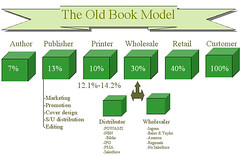The Economics of Trade Book Publishing
To understand the opportunity in book printing, one must understand how the trade book publishing industry makes money. How much money each member of the book publishing value chain makes will help determine whether or not it is economically feasible to enter this market.
The trade book publishing model is 20th century thinking. It is based on bookstores distributing the books. Bookstores rely on distributors to supply the books. Distributors are relatively new intermediaries. They became important to the distribution chain in the past 25 years because bookstores prefer ordering from and paying one single source for many publishers’ titles rather than numerous publishers.
The entire value chain of trade book publishing looks like the illustration below. I entitle it “The Old Book Model” because it represents old thinking. Newer forms of distribution, such as the Internet, may supplant this model in the future.
The author of a book earns only 5%-7% of the list price of a book. Most of this money is paid in the form of an advance against royalties. Typical advances for lesser known authors amounts to $5,00-$7,500. Most books sales do not cover the advance that publishers pay to authors, according to Publishers Weekly.
The publisher earns 13% of the list price of a book. The publisher assumes all the risk of paying royalties, typesetting, printing, marketing and promoting the book.
Book printers earn about 10% of the book’s list price in The Old Book Model. Their role is to print the final product and deliver it to the distribution channels.
The distribution channel for trade books is where The Old Book Model becomes complicated. There are two types of companies from which a bookstore can buy books: wholesalers and distributors. Wholesalers, such as Ingram for bookstores and Baker and Taylor for libraries, simply ship books to bookstores when the books are ordered. They do not have an outside sales force promoting books to bookstores. Distributors, such as Publishers’ Group West or Koen Brothers, have sales forces that actively sell to bookstore buyers. The bookstore buyers then have the option of buying the books from the distributor or from the wholesaler. If the bookstore buyer elects to buy from the wholesaler, then the distributor sells to the wholesaler who then sells to the bookstore.
Most wholesalers today will not buy books from a publisher that has less than 10 titles. This forces smaller publishers to use a distributor to sell books to bookstores. Distributors take a large piece of the action—typically buying the books for 30% of the list price. They take this 70% discount because they must sell to either the bookstore at a 40% discount or to a wholesaler for a 55% discount.
To use an example of a trade paperback book selling for $19.95 (which I will round up to $20 to make the math easier), the author earns up to $1.40 per book. The publisher earns $2.60 per book. The printer earns $2.00 per book. The distributor earns $3.00 per book. The wholesaler earns $3.00 per book. The retailer earns the remaining $8.00.
The lesson for book printers, therefore, is that they are only 10% of the value chain for a trade book. This impacts they way in which publishers view book printers, as a necessary evil, and a small part of their overall picture. More importantly, each book printer must decide whether or not they can make a profit being only 10% of the value of the book. If yes, then this can be an exciting and profitable market. If not, then consider industrial books as an alternative market or get out of book printing altogether.


0 Comments:
Post a Comment
<< Home